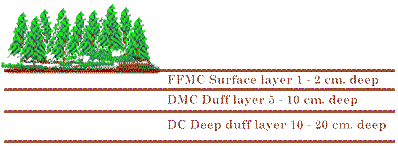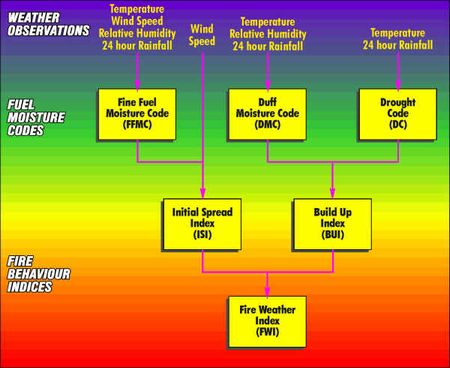| FIRE WEATHER INDEX (FWI) |
The Fire Weather Index (FWI) System is the first part of the Canadian Forest
Fire Danger Rating System (CFFDRS) introduced into New Zealand in 1980. It has
proved to be a suitable fire danger rating system for this country. The FWI was
evaluated for several seasons before it was introduced for the 1980-81 fire
season.
The FWI is based on weather readings taken at noon standard time and rates fire
danger at the mid afternoon peak from 2:00 - 4:00 pm.
Weather readings required are:
* Air temperature (in the shade)
* Relative Humidity (in the shade)
* Wind speed (at 10 metres above ground level for an average over 10 minutes)
* Rainfall (For the previous 24 hours)
The Fire Weather Index has six components:
Three Fuel Moisture Codes
1. Fine Fuel Moisture Code
2. Duff Moisture Code
3. Drought Code

Three Fire Behaviour Indices
1. Initial Spread index
2. Build Up Index
3. Fire Weather Index
FWI CALCULATIONS
The fire weather index calculation structure.
Interpretation of FWI Codes and Indices
To interpret the system the three fuel moisture codes and the three behaviour indices need to be understood. Each code and index is a numerical rating related to likely fire behaviour. The scales start at zero, and except for the Fine Fuel Moisture Code which has a maximum of 99, all are open-ended. Low ratings indicate high moisture content, and ratings rise as moisture content decreases. Ratings rise as fire weather becomes more severe.
Fuel Moisture Codes
The FWI System evaluates fuel moisture content and relative fire behaviour using past and present weather effects on ground level fuels. The moisture codes reflect the nett effects of daily moisture gains and losses.
Fine Fuel Moisture Code - FFMC
This is a numerical rating of the moisture content of surface litter and other cured fine fuels. It shows the relative ease of ignition and flammability of fine fuels. The moisture content of fine fuels is very sensitive to the weather. Even a day of rain, or of fine and windy weather, will significantly affect the FFMC rating. The system uses a time lag of two-thirds of a day to accurately measure the moisture content in fine fuels. The FFMC rating is on a scale of 0 to 99. Any figure above 70 is high, and above 90 is extreme.
Duff Moisture Code - DMC
DMC is a numerical rating of the average moisture content of loosely compacted organic layers of moderate depth. The code indicates the depth that fire will burn in moderate duff layers and medium size woody material. Duff layers take longer than surface fuels to dry out but weather conditions over the past couple of weeks will significantly affect the DMC. The system applies a time lag of 12 days to calculate the DMC. A DMC rating of more than 30 is dry, and above 40 indicates that intensive burning will occur in the duff and medium fuels. Burning off operations should not be carried out when the DMC rating is above 40.
Drought Code - DC
The DC is a numerical rating of the moisture content of deep, compact, organic layers. It is a useful indicator of seasonal drought and shows the likelihood of fire involving the deep duff layers and large logs. A long period of dry weather (the system uses 52 days) is needed to dry out these fuels and affect the Drought Code. A DC rating of 200 is high, and 300 or more is extreme indicating that fire will involve deep sub-surface and heavy fuels. Burning off should not be permitted when the DC rating is above 300.
Fire Behaviour Indices
The three behaviour indices are relative to the fuel moisture content. They indicate what a fire is likely to do. The lower the moisture content, the higher the Fuel Moisture Codes, and the higher the Fire Behaviour Indices - and the more active the fire will be.
Initial Spread Index - ISI
This indicates the rate fire will spread in its early stages. It is calculated from the FFMC rating and the wind factor.
The open-ended ISI scale starts at zero and a rating of 10 indicates high rate of spread shortly after ignition. A rating of 16 or more indicates extremely rapid rate of spread.
Build -Up Index - BUI
This index shows the amount of fuel available for combustion, indicating how the fire will develop after initial spread. It is calculated from the Duff Moisture Code and the Drought Code.
The BUI scale starts at zero and is open-ended. A rating above 40 is high, above 60 is extreme.
Fire Weather index - FWI
Information from the ISI and BUI is combined to provide a numerical rating of fire intensity - the Fire Weather Index.
| Index | Low | Moderate | High | Very High | Extreme |
|---|---|---|---|---|---|
| FFMC | 0-81 | 81-88 | 88-90.5 | 90.5-92.5 | 92.5+ |
| DMC | 0-13 | 13-28 | 28-42 | 42-63 | 63+ |
| DC | 0-80 | 80-210 | 210-274 | 274-360 | 360+ |
| ISI | 0-4 | 4-8 | 8-11 | 11-19 | 19+ |
| BUI | 0-19 | 19-34 | 34-54 | 54-77 | 77+ |
| FWI | 0-5 | 5-14 | 14-21 | 21-33 | 33+ |
Interpreting The Information
1. The moisture codes (FFMC, DMC and DC) indicate what fuels will be involved and their ease of ignition. This will vary during the season. Each code must be considered to assess potential burning characteristics.
Example: 1
FFMC = 86 DMC = 25 DC = 120
These ratings indicate:
* fine fuels will ignite easily
* fire will involve the light fuels and to a limited extent the medium and duff layer fuels
* fire will not become deep seated
Example: 2
FFMC = 94 DMC = 45 DC = 320
These ratings indicate:
* fine fuels will ignite extremely easily
* fire will involve all fuel levels
* extreme fire behaviour is likely
2. The fire behaviour indices (ISI, BUI, FWI) indicate the likely initial spread, total fuel availability, and potential intensity.
Example: 3
ISI = 5 BUI = 120 FWI = 21
These ratings indicate:
* slow initial spread
* high volume of fuel available for combustion
* potentially high level of fire intensity
In general terms, a hot, but slow moving fire. The type of fire likely to occur on a windless day in mid-summer after a long dry period.
Example: 4
ISI = 25 BUI = 10 FWI = 21
Note the same FWI as example 3.
These ratings indicate:
* extremely fast initial spread
* low volume of fuel available for combustion
* potentially high level of intensity
In general, a fast moving fire involving fine fuels only.
Likely to be either:
1. a fire in early spring of late autumn when medium and heavy fuels have a moisture content and winds are strong, or
2. a fire after rain on a day with strong winds